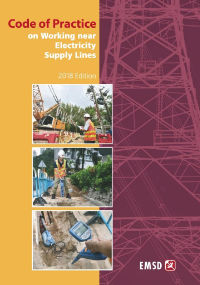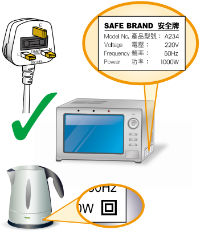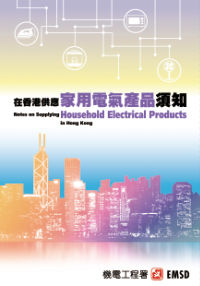Feature Article
Feature Article 1 - Statutory Requirements on Generating Facilities Under the Electricity Ordinance
Feed-in Tariff Scheme
The new Scheme of Control Agreements (Agreements) that the Government of the Hong Kong Special Administrative Region entered into with the two power companies (i.e. CLP Power Hong Kong Limited and The Hongkong Electric Company, Limited) in April last year will take effect on 1 October 2018 and 1 January 2019 respectively. Under the new Agreements, the power companies will introduce a feed-in tariff scheme to encourage the development of distributed renewable energy.
By participating in the feed-in tariff scheme, private organisations can sell the power generated by their renewable energy installations (i.e. solar or wind power systems) to the power companies at a rate higher than the normal electricity tariff rate, subject to compliance with the relevant safety and technical requirements. For details of the feed-in tariff scheme, please refer to the respective announcements of the two power companies.
The Electrical and Mechanical Services Department (EMSD) has updated its website "HK RE Net" and set up a one-stop enquiry hotline (Tel.: 6395 2930) to enhance public understanding of the information on installation of renewable energy systems and answer related questions.
Statutory Requirements on Generating Facilities Under the Electricity Ordinance
(1) General Technical and Safety Requirements
The electrical safety matters of a renewable energy power system are regulated by the Electricity Ordinance (Cap. 406) (EO) as it is a fixed electrical installation, irrespective of whether it is connected to a power grid. Therefore, the installation must comply with the requirements of the Electricity (Wiring) Regulations (Cap. 406E) and the Code of Practice for the Electricity (Wiring) Regulations (CoP). For example, given the varied quality and sources of the products supplied on the market, registered electrical contractors and registered electrical workers, when choosing and using electrical installations (including solar photovoltaic panels, inverters, circuit breakers and isolation switches, etc.), must comply with the requirements of Code 4 of the CoP to ensure that the installations selected are of sound quality and meet the specifications of national or international standards, and that they are purposely designed for the intended use (including use under adverse environmental conditions) so as to avoid posing fire or electrical hazards and causing damage to other equipment.
Besides, the EMSD has published the Technical Guidelines on Grid Connection of Renewable Energy Power Systems to provide details on grid connection of renewable energy power systems, which include the related safety requirements (e.g. providing an "anti-islanding" function and "dual power supply sources" warning labels, and using lockable switches and four-pole circuit breakers or isolation switches), as well as specifying that the installations must comply with the safety requirements of the EO and the CoP.
Therefore, electrical works for a renewable energy power system must be carried out by a registered electrical contractor and a registered electrical worker of appropriate grade in accordance with the EO. After completion of the works and before the installation is energised for use, the registered electrical contractor and registered electrical worker shall issue a Work Completion Certificate (i.e. Form WR1) in accordance with the Electricity (Wiring) Regulations to confirm that the installation complies with the requirements of the EO and its subsidiary regulations.
(2) Registration Requirements
Under section 21(1) of the EO, the owner of a generating facility (in use or on standby use) which produces electricity at low voltage or high voltage shall register it with the Director of Electrical and Mechanical Services (the Director) unless it:
- forms part of an electrical installation that requires a periodic test certificate to be submitted to the Director under the EO;
- only supplies electricity to an electrical installation that is owned by the owner of the generating facility;
- is used on an aircraft;
- is used on a watercraft;
- is used on a hovercraft;
- is on a land vehicle where the facility is not connected to a wiring installation outside the vehicle; or
- is used in construction work as defined and regulated under the Factories and Industrial Undertakings Ordinance (Cap. 59).
The owner of a renewable energy generating facility connected to a power grid and installed in a general village house or building unit with an approved loading of electrical installations not exceeding 100A (i.e., does not form part of an electrical installation covered under a periodic test certificate (Form WR2)) shall register the facility with the Director.
In this connection, section 14 of the Electricity (Registration) Regulations (Cap. 406D) stipulates that an owner who applies to register a generating facility shall submit to the Director an application in a form required by the Director (i.e. Form GF1), documents that the Director considers are relevant to the applicant's registration and a one-off application fee of HK$640 specified in the Schedule of the Regulations. Once the generating facility is successfully registered, no renewal of registration will be required.
The owner of a generating facility registered with the EMSD will be issued a certificate of registration which shall be displayed at the facility in accordance with section 21(3) of the EO. No person shall use an unregistered generating facility that is required to be registered under the EO. Anyone who contravenes such requirement commits an offence and is liable to a fine of HK$10,000.
For details of application for registration as a generating facility, please refer to the website of the EMSD.
(3) Maintenance Requirements
Under section 22 of the EO, the owner of a registered generating facility shall maintain the generating facility in continuous safe working order, and display at the facility a notice showing the name and registration number of the registered electrical contractor employed for maintaining the facility in continuous safe working order.
Apart from owners of registered generating facilities, the owners of the following generating facilities, for which registration is not required, shall also comply with the above two requirements under section 22 of the EO:
- a generating facility which is used in construction work as defined and regulated under the Factories and Industrial Undertakings Ordinance;
- a generating facility which forms part of an electrical installation that requires a periodic test certificate to be submitted to the Director under the EO; or
- a generating facility which only supplies electricity to an electrical installation that is owned by the owner of the generating facility.
Feature Article
Feature Article 2 - Points to Note on the Code of Practice for the Electricity (Wiring) Regulations (2015 Edition)
Members of the trade should already be aware of the full implementation of the Code of Practice for the Electricity (Wiring) Regulations (2015 Edition) (CoP) on 30 November 2017. Apart from the Electrical and Mechanical Services Department (EMSD) which will monitor the performance of registered electrical workers and registered electrical contractors with electrical safety standards under the new revisions, power companies will also carry out inspections on fixed electrical installations following the new revisions when processing the applications for electricity supply connection, so please remember to comply with the new revisions of the CoP when conducting electrical work. Let us now revisit some major revisions and relevant points to note:
1. Use of Lockable Switches
To prevent occurrence of electrical incidents caused by accidental switch-on of miniature circuit breakers (MCB) or moulded case circuit breakers (MCCB) during electrical work, the CoP requires that MCB and MCCB should be equipped with lockable function. Such requirement applies only to newly installed or altered devices. Existing switches do not need to be replaced for compliance with this new requirement. Given that most of the MCB currently available on the market may only be locked by adding assistive locking devices, please remember to provide appropriate assistive locking devices for newly installed MCB for compliance with the requirements of the CoP. (Note: Since existing MCB or MCCB may not be equipped with assistive locking devices when they were manufactured, it is advised to add assistive locking devices on your own where practicable in order to prevent occurrence of electrical incidents caused by accidental switch-on of circuit breakers during electrical work and to protect yourself.)
2. Permit-to-Work Shall Be Issued for Carrying out Electrical Work on De-energised Equipment
Under Code 4G(1)(e), where danger cannot be avoided for work on energised equipment, the electrical equipment should be isolated and verified dead with an approved voltage indicator; and a permit-to-work should be issued. The permit-to-work (Appendix 16A) in the CoP has been revised to facilitate use by trade workers. Please be reminded that before carrying out electrical work on de-energised equipment, the responsible person shall issue a permit-to-work to the person-in-charge (Notes 1 and 2) to ensure work safety.
3. Electrical Safety Assessment Shall Be Carried out for Live Work
As stipulated in Code 4G(1)(d) and Appendix 15(A)(2)(ii), where live work (including live work on equipment that cannot be completely isolated from electricity supply) is unavoidable, electrical safety assessment should first be carried out by a responsible assessor. The original Risk Assessment Report on Live Work has been replaced by the simplified Electrical Safety Assessment Form (Appendix 15B) (Notes 1 and 2) in the current CoP. This not only reduces the parts to be filled out with text, but also allows the required assessment work to be conducted by trade workers following simplified procedures. Please remember that an assessment on the potential risks shall first be made by the responsible assessor with relevant control measures recommended before carrying out live electrical work.
 Besides, "isolation" is also defined in detail in the CoP, which specifies that working on the three-phase four-wire alternating current system without disconnecting its neutral conductor from electricity supply is not regarded as complete "isolation". Furthermore, from the analysis of some previous electrical accidents, there is a certain degree of danger (e.g. "current from neutral") associated with electrical work where the neutral conductor is not isolated. As working on the three-phase four-wire alternating current system without disconnecting its neutral conductor from electricity supply is regarded as live work, electrical safety assessment must first be carried out in accordance with the requirements of the new edition of the CoP. For details of the requirements, please refer to Code 8A(1)(a).
Besides, "isolation" is also defined in detail in the CoP, which specifies that working on the three-phase four-wire alternating current system without disconnecting its neutral conductor from electricity supply is not regarded as complete "isolation". Furthermore, from the analysis of some previous electrical accidents, there is a certain degree of danger (e.g. "current from neutral") associated with electrical work where the neutral conductor is not isolated. As working on the three-phase four-wire alternating current system without disconnecting its neutral conductor from electricity supply is regarded as live work, electrical safety assessment must first be carried out in accordance with the requirements of the new edition of the CoP. For details of the requirements, please refer to Code 8A(1)(a).
News-in-brief
News-in-brief 1 - Registered Electrical Workers Are Required to Complete the Continuing Professional Development Training
The Continuing Professional Development (CPD) Scheme for Registered Electrical Workers (REWs) has been included as a requirement for renewal of registration of electrical workers since 1 January 2012. Under the CPD Scheme, all REWs are required to have completed two modules of training, including Module (1): Legislative and Safety Requirements and Module (2): Technical Knowledge, every time before submitting their applications for renewal of registration.
REWs are reminded to complete the CPD training required within the three-year period before expiry of their current certificates of registration. To ensure there is enough time to prepare for and complete the training, REWs should start the relevant training at an earlier stage of the three-year period before expiry of their current certificates of registration as far as possible.
For details of the CPD Scheme, please refer to the website of the EMSD.
News-in-brief
News-in-brief 4 - Code of Practice on Working near Electricity Supply Lines (2018 Edition)
To ensure that works carried out in the vicinity of underground electricity cables and overhead electricity lines do not prejudice safety and the continuity of electricity supply, the Electrical and Mechanical Services Department (EMSD) has developed the Code of Practice on Working near Electricity Supply Lines (CoP) under the Electricity Supply Lines (Protection) Regulation. The CoP stipulates in detail the work procedures and methods that meet the statutory requirements in order to prevent the occurrence of electrical accidents or power disruption incidents arising from damage to electricity supply lines.
To allow for safer and more reliable electricity supply as well as provide clearer guidelines to relevant parties, the EMSD has made a series of revisions to the CoP after consultation. Major revisions are as follows:

- Provide additional diagrams and illustrations in order to facilitate the working parties including the front line workers to understand the safety requirements;
- Standardise the format of cable detection report prepared by Competent Person (CP) and enrich the content such as including a note to remind the working party to complete active cable detection so as to ascertain the depth and alignment of the underground cable. Keep records to show that the working parties engaged in excavation work had attended the briefing conducted by CP before excavation; and
- Require to keep a copy of the cable detection report on site for working parties and relevant government departments' reference during the inspection.
The new edition of the CoP was gazetted on 29 June this year and will take effect on 29 December 2018 after a six-month grace period. The soft copy of the new edition of the CoP can be downloaded for free at the EMSD website, while its hard copy is available for purchase at the Publications Sales Unit, Room 626, 6/F, North Point Government Offices, 333 Java Road, North Point. Orders can also be made via telephone (2537 1910), the Online Government Bookstore or e-mail. During this period, the EMSD will organise activities such as seminars, technical forums and talks to help the trade understand the various revisions to the new edition of the CoP and comply with the new safety requirements.
 [PDF format (1.74MB)]
[PDF format (1.74MB)] Besides, "isolation" is also defined in detail in the CoP, which specifies that working on the three-phase four-wire alternating current system without disconnecting its neutral conductor from electricity supply is not regarded as complete "isolation". Furthermore, from the analysis of some previous electrical accidents, there is a certain degree of danger (e.g. "current from neutral") associated with electrical work where the neutral conductor is not isolated. As working on the three-phase four-wire alternating current system without disconnecting its neutral conductor from electricity supply is regarded as live work, electrical safety assessment must first be carried out in accordance with the requirements of the new edition of the CoP. For details of the requirements, please refer to Code 8A(1)(a).
Besides, "isolation" is also defined in detail in the CoP, which specifies that working on the three-phase four-wire alternating current system without disconnecting its neutral conductor from electricity supply is not regarded as complete "isolation". Furthermore, from the analysis of some previous electrical accidents, there is a certain degree of danger (e.g. "current from neutral") associated with electrical work where the neutral conductor is not isolated. As working on the three-phase four-wire alternating current system without disconnecting its neutral conductor from electricity supply is regarded as live work, electrical safety assessment must first be carried out in accordance with the requirements of the new edition of the CoP. For details of the requirements, please refer to Code 8A(1)(a).


